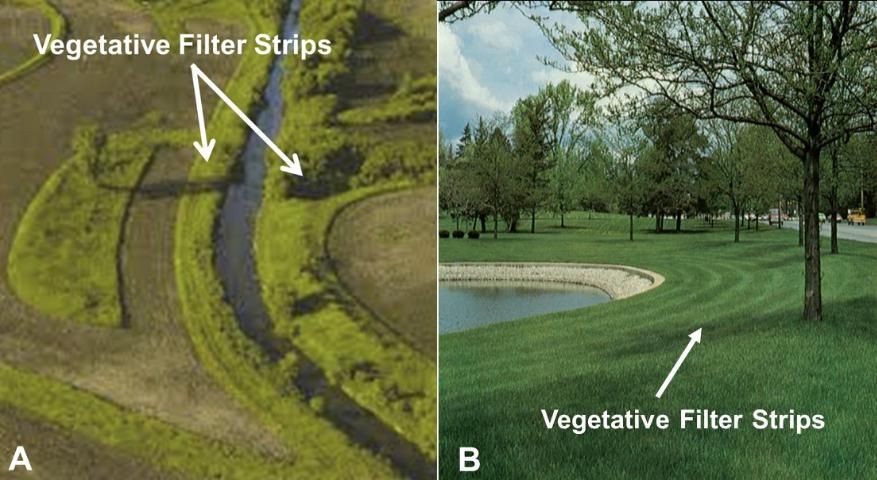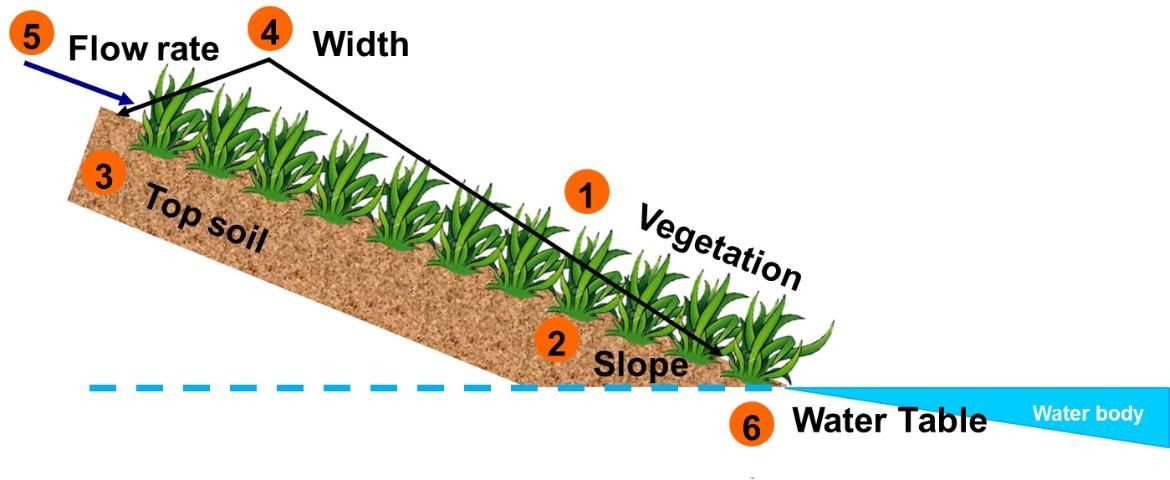Introduction
Agriculture has had considerable success increasing production to meet the growing demand for food, feed, fiber, and fuel. However, this success has consequences for water quality. In addition to climate impacts and land use change, increasing numbers of pollutants, such as pesticides, nutrients, and heavy metals, have been observed in natural water systems. As awareness of the agricultural sources of water pollution has grown, Best Management Practices (BMPs) have been designed to address agricultural sources of pollutants and protect water quality. This publication introduces one of the BMPs—Vegetative Filter Strips (VFSs), which efficiently control nonpoint pollution such as sediments, nutrients, and pesticides that cannot be traced to a specific source.
What is a vegetative filter strip (VFS)?
A vegetative filter strip (VFS) is an area of vegetation designed to remove sediment and other pollutants from surface water runoff through filtration, deposition, infiltration, adsorption, absorption, decomposition, and/or volatilization. Filter strips were originally used as an agricultural treatment practice but have recently evolved into an urban practice as well. Within an agricultural context, vegetative filter strips are generally referred to as banded areas of planted or indigenous vegetation which are positioned between a potential pollutant source area (cropland) and a surface water body that receives runoff (Figure 1A). They are often used in conjunction with other BMPs, such as proper nutrient and pest management to protect water quality. Several state and federal agencies (e.g., EPA) have included VFSs in their arsenal of agricultural BMPs. Within an urban context, VFSs are gently sloping, vegetated areas adjacent to impervious surfaces (Figure 1B), such as sidewalks and roadways.

Credit: A) Southeastern Wisconsin Regional Planning Commission; and B) Florida Department of Environmental Protection
Although VFSs are effective in the removal of pollutants from urban stormwater runoff in Florida, VFSs are not widely used in agricultural pollution control, mainly for the following reasons: 1) runoff flow in open fields is limited due to sandy (or gravelly) soils found in most areas (water infiltrates readily, leaving little on the surface for runoff), and 2) shallow water presence (or inundation) reduces the infiltration time. However, this does not mean VFSs are not useful for the Florida agricultural landscape. In fact, VFSs should be used regularly in limited infiltration soils (especially in south Florida marl soils) and canal banks to offer protection from large precipitation events that might generate runoff.
What are the primary functions of VFSs?
The United States Environmental Protection Agency (EPA) encourages growers to use engineered VFSs to reduce nonpoint source (NPS) pollution (US EPA 2002). NPS pollution is pollution that cannot be traced to a direct source and usually results from runoff and precipitation. Table 1 summarizes the efficacy of several VFSs in the removal of pollutants from cropland and feedlot runoff. Although there is an argument that the ability of VFSs to remove NPS pollutants depends on the design and maintenance of the filter strips, these field studies clearly indicate that VFSs can successfully remove more than 90% of sediments, 50 to 80% of nutrients, and 44 to 100% of the herbicide atrazine if they are properly designed. Therefore, it is reasonable to expect comparable pollutant removal efficacy if VFSs are properly designed and applied in infiltration soil in south Florida.
What are the key design factors of VFSs?
Key factors to consider when designing VFSs are listed on the US EPA website (http://water.epa.gov/polwaste/nps/czara/ch7-2c.cfm) under the section "Management Measure for Vegetated Treatment Systems." A summary of these key factors is presented below (Figure 3).
- Vegetation: Sturdy, tall, perennial native grass species generally do the best job of removing sediment. The USDA-NRCS "VegSpec" website is a web-based support system which can help you select appropriate grass species for VFSs.
- Slope: Extensive field studies indicate that VFSs work best on slopes that are less than 5% and are usually not recommended for slopes greater than 15%. Increased steepness increases runoff velocity, resulting in decreased sediment deposition by filter strips. It is also noted that the slope of the drainage area above the filter strip needs to be 1% or greater to allow runoff to enter the VFSs. Slopes less than 1% will cause runoff and sediment to back up into the contributing area and not enter the VFSs.
- Soil: When agricultural runoff passes through a buffer strip, the vegetation slows down the flow velocity, which provides time for the water to infiltrate and then percolate into the soil profile. As a result, sediment and other pollutants settle out of the runoff. This process is largely affected by the soil conditions (e.g., size of soil particles, aggregate stability, available water capacity, and particulate organic matter). Rocky soils in south Florida pinelands are not ideal locations for VFSs because water can easily infiltrate them. However, marl soils which cover low-lying lands in south Florida could be considered for VFS application.
- Width: Generally, wider filter strips perform better than narrower ones. The filter strip width should be great enough to effectively trap clay-sized particles which require the lowest velocities through the filter. A recent Field Office Technical Guide (NRCS 2016) indicates that 6 m (20 feet) is the minimum flow length (width) through the filter strip.
- Flow: Most of the studies on VFSs assume that the flow of agricultural runoff is sheet flow across the buffer filter. However, natural berms often cause concentrated flows which may dramatically reduce the pollutant-trapping efficiency of the VFSs (Figure 2). Therefore, to promote removal efficiency, one must maintain sheet flow where runoff enters edge-of-field filter strips.

Credit: L. Wu
- Presence of shallow water table: Recent research shows that the presence of a shallow water table in the soil profile reduces the efficiency of VFSs. A seasonally high water table can be a condition of bottomland areas in stream backs, flat plains, or poorly drained soils which are typical in Florida. This limits the soil infiltration, which, in turn, increases the portion of the total water (field runoff and rainfall) that becomes surface runoff through the VFSs, and decreases sediment and pollutant trapping. This important effect becomes apparent when the water table is 1 to 2.5 m from the soil surface, depending on soil type.

Credit: L. Wu
When designing VFSs, growers face a complex system where a large number of parameters and uncertainties need to be taken into account. To solve this problem, a design-oriented Vegetative Filter Strip Modeling System (VFSMOD-W) (https://abe.ufl.edu/faculty/carpena/vfsmod/index.shtml) has been developed. This Microsoft Windows graphical user interface (GUI) includes four main components: a numerical model VFSMOD, a utility which is used to generate source (upslope disturbed area) inputs for the model based on readily available NRCS site characteristics, uncertainty and sensitivity analysis components, and inverse calibration and design menu-driven components. VFSMOD-W has been tested in a variety of settings (agroforestry, mining and roads). The model predictions have good agreement with measured values of infiltration, outflow, and vegetation trapping efficiency for sediments, phosphorus (particulate and dissolved), and pesticides. The model, which was originally developed as a research tool, is now widely used by consultants, planners, and regulators to design optimal filter strips for specific sites or to assess the effectiveness of existing VFSs.
Can VFSs remove emerging pollutants?
As discussed before, VFSs can effectively reduce traditional NPS pollutants (e.g., sediment and solute). However, it is unclear whether VFSs are also effective against emerging colloidal contaminants, such as pathogens, heavy metals, and engineered nanoparticles. To address this, Dr. Muñoz-Carpena's lab (http://abe.ufl.edu/carpena/index.shtml) has conducted a series of laboratory experiments (Figure 4) to investigate effects of dense vegetation on colloid contaminant transport through and removal from surface runoff. The results indicate that both surface vegetation and soil (including plant roots) can remove colloids from surface and subsurface flows. Solution chemistry and vegetation type were identified as key factors that have a significant effect on the removal of colloidal particles. Furthermore, a refined vegetation filtration theory has been developed to help construct and improve the design-oriented Vegetative Filter Strip Modeling System (Wu et al. 2014). The laboratory findings suggest that well-designed and maintained vegetative filter strips can be used as a best management practice to reduce colloidal contaminants in surface runoff. Currently, Dr. Muñoz-Carpena's lab is in the process of upscaling laboratory findings to field scale.

Credit: B. Gao
Summary and Maintenance
Properly designed filter strips have the potential to be used in limited infiltration soils in south Florida to reduce the spread of nonpoint source pollutants. Further studies are needed to optimize the performance of VFSs based on Florida's unique landscape. To maintain optimal pollutant removal efficiency, permanent vegetative plants should be harvested properly to encourage dense growth and removal of sediment, nutrients, and other pollutants trapped in the plant tissue. Regular inspection of VFSs is recommended, especially after storm events, to assist in the removal of unevenly deposited sediment accumulation, the repair of any newly formed gullies, and the replantation of disturbed areas. Application of supplemental nutrients and soil amendments is also recommended, if necessary, to maintain desired species composition and soil health.
References
Barfield, B. J., R. L. Blevins, A. W. Fogle, C. E. Madison, S. Inamdar, D. I. Carey, and V. P. Evangelou. 1998. "Water quality impacts of natural filter strips in karst areas." Transactions of the ASAE 41: 371–80.
Dillaha, T. A. 1989. "Vegetative filter strips for agricultural non-point source pollution control." Transactions of the ASAE 32: 513–19.
Florida Department of Environmental Protection. 1995. "Stormwater management—A guide for Floridians." https://chnep.wateratlas.usf.edu/upload/documents/Stormwater_Guide_for_Floridians.pdf. Accessed December 30, 2024.
Li, Y., and K. Migliaccio. 2011. Water Quality Concepts, Sampling, and Analyses. Boca Raton: CRC Press, 75–76.
Li, Y. 2001. Calcareous Soils in Miami-Dade County. SL183. Gainesville: University of Florida Institute of Food and Agricultural Sciences. https://edis.ifas.ufl.edu/tr004. Accessed October 28, 2015.
Moore, M. T., E. R. Bennett, C. M. Cooper, S. Smith, F. D. Shields, C. D. Milam, and J. L. Farris. "Transport and fate of atrazine and lambda-cyhalothrin in an agricultural drainage ditch in the Mississippi Delta, USA." Agriculture, Ecosystems & Environment 87: 309–14.
Muñoz-Carpena, R., J. E. Parsons, and J. W. Gilliam. 1999. "Modeling hydrology and sediment transport in vegetative filter strips." Journal of Hydrology 214: 111 – 29.
NRCS, 2016. "Natural Resources Conservation Service Conservation Practice Standard, filter strip." https://www.nrcs.usda.gov/sites/default/files/2022-09/Filter_Strip_393_CPS.pdf. Accessed December 30, 2024.
Parsons, J. E., J. W. Gilliam, R. Muñoz-Carpena, R. B. Daniels, and T. A. Dillaha. 1994. "Nutrient and sediment removal by grass and riparian buffers." Paper presented at the Environmentally Sound Agriculture: proceedings of the second conference: 20-22 April 1994.
Robinson, C. A., M. Ghaffarzadeh, and R. M. Cruse. 1996. "Vegetative filter strip effects on sediment concentration in cropland runoff." Journal of Soil and Water Conservation 51: 227–30.
Schmitt, T. J., M. G. Dosskey, and K. D. Hoagland. 1999. "Filter strip performance and processes for different vegetation, widths, and contaminants." Journal of Environmental Quality 28: 1479–89.
Southeastern Wisconsin Regional Planning Commission. 2010. "Managing the water's edge—Making natural connections." http://www.sewrpc.org/SEWRPCFiles/Environment/RecentPublications/ManagingtheWatersEdge-brochure.pdf. Accessed October 28, 2015.
USDA-NRCS. 1999. "The national conservation buffer initiative." Washington: USDA National Resources Conservation Service, 53.
US EPA. 2002. "Considerations in the design of treatment Best Management Practices (BMPs) to improve water quality." http://nepis.epa.gov/Adobe/PDF/2000D1JS.PDF. Accessed October 28, 2015.
Wu, L., R. Muñoz-Carpena, B. Gao, W. Yang, and Y. A. Pachepsky. 2014. "Colloid filtration in surface dense vegetation: Experimental results and theoretical predictions." Environmental Science & Technology 48: 3883–90.